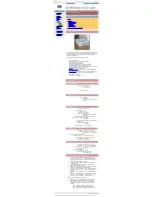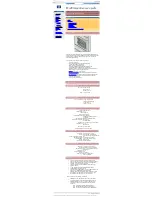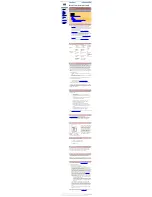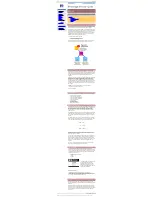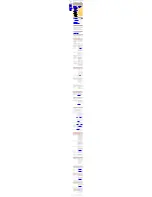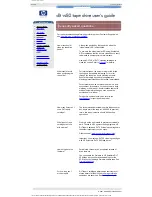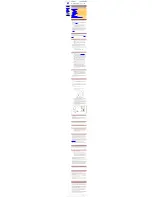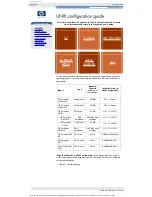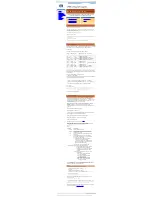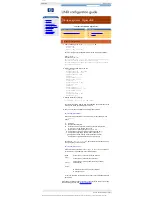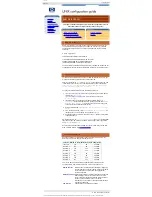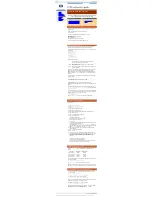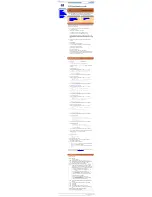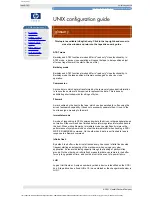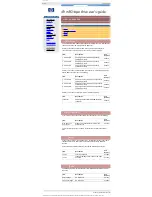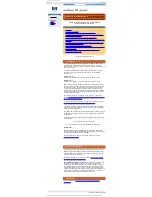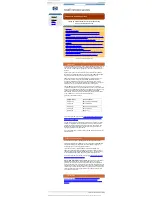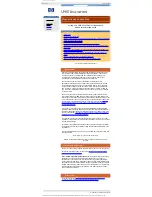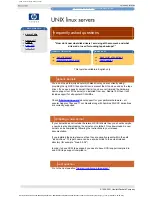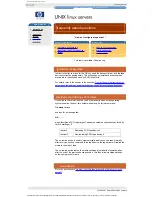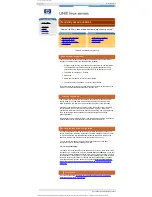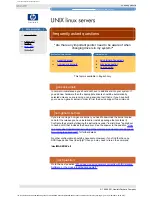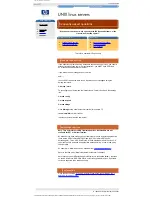
UNIX sun
hp learning products
http://www.hp.com/support/tape
may have a later version
UNIX configuration
introduction
hp systems
compaq systems
ibm RS/6000 systems
pc based UNIX systems
silicon graphics
sun systems
verify installation
UNIX glossary
Sun Systems 2.x, 5.x, 8
This topic is available in English only. Click in the top right-hand corner to
close the window and return to the tape drive user's guide.
contents of this section
determining the SCSI ID
configuring the device files
hp-data values
related topics
verifying installation
glossary
determining the SCSI id
Before you configure your system to support your new HP Surestore drive, you
need to determine what SCSI ID to use. The SCSI ID must be unique for each
device attached to the SCSI bus.
1
Check for existing SCSI controllers using the following command:
% modinfo | grep "SCSI"
This will produce output similar to the following:
21 101ea5fa 14d7f 102 1 isp (ISP SCSI HBA Driver 1.205)
25 10207d97 c516 50 1 glm (GLM SCSI HBA Driver 1.154.)
This indicates that there are two SCSI controllers on the system, an ISP-
based adapter and a GLM-based adapter. For the adapter to which the new
tape drive is attached, you will need to determine what SCSI IDs are already
used.
2
Determine the SCSI IDs of the existing devices attached to the SCSI
controller:
For all adapters:
% dmesg | egrep ".*xxx.*target" | sort | uniq
where xxx = the type of adapter (esp, glm, fas or isp), as appropriate.
For example, for an ESP-based adapter:
% dmesg | egrep ".*esp.*target" | sort | uniq
This produces a list similar to:
sd0 at esp0: target 0 lun 0 sd6 at esp0: target 6 lun 0
This indicates that SCSI IDs 0 and 6 are used for existing devices. SCSI ID
7 is generally used for the adapter itself. In this situation, you would use a
SCSI ID from 1 to 5 for the new tape drive.
configuring the device files
Only if necessary, make the following file modifications to enhance performance:
1
In the file
/kernel/drv/st.conf
, locate these lines:
########
# Copyright (c) 1992, by Sun Microsystems, Inc.
#ident "@(#)st.conf 1.6 93/05/03 SMI"
and add the appropriate
tape-config-list =
lines for your tape drive,
as follows:
HP Surestore Ultrium drives
(there are 6 significant spaces between
HP
and
Ultrium
in line 2):
tape-config-list =
"HP Ultrium", "HP Ultrium", "ULTRIUM",
ULTRIUM = 1,0x36,0,0xd639,4,0x00,0x00,0x00,0x40,3;
name="st" class="scsi"
target=X lun=0;
where
X
is the SCSI target address of the device you have attached.
HP Surestore DAT24 drives
(there are 6 significant spaces between
HP
and
C1537A
in line 2):
tape-config-list =
"HP C1537A", "HP DDS3 4mm DAT", "HP-data2",
HP-data2 =
1,0x34,1024,0xd639,4,0x00,0x13,0x24,0x3,3;
name="st" class="scsi"
target=X lun=0;
where
X
is the SCSI target address of the device you have attached.
HP Surestore DAT24x6 autoloaders
(there are 6 significant spaces between
HP
and
C1557A
in line 2):
tape-config-list =
"HP C1557A", "HP DDS3 4mm DATloader", "HP-
data2";
HP-data2 =
1,0x34,1024,0xd639,4,0x00,0x13,0x24,0x3,3;
name="st" class="scsi"
target=X lun=0;
where
X
is the SCSI target address of the device you have attached.
HP Surestore DAT40 drives
(there are 6 significant spaces between
HP
and
C5683A
in line 2):
tape-config-list =
"HP C5683A", "HP DDS4 4mm DAT", "HP-data2",
HP-data2 =
1,0x34,1024,0xd639,4,0x00,0x13,0x24,0x3,3;
name="st" class="scsi"
target=X lun=0;
where
X
is the SCSI target address of the device you have attached.
HP Surestore DAT40x6 autoloaders
(there are 6 significant spaces between
HP
and
Ultrium
in line 2):
tape-config-list =
"HP C5713A", "HP DDS4 4mm DATloader", "HP-
data2",
HP-data2 =
1,0x34,1024,0xd639,4,0x00,0x13,0x24,0x3,3;
name="st" class="scsi"
target=X lun=0;
where
X
is the SCSI target address of the device you have attached.
HP Surestore SDLT drives
tape-config-list =
"Quantum SuperDLT1", "HP SDLT", "SDLT",
SDLT = 1,0x36,0,0xd639,4,0x00,0x00,0x90,0x91,3;
name="st" class="scsi"
target=X lun=0;
where
X
is the SCSI target address of the device you have attached.
HP Surestore DLTvs drives
tape-config-list =
"BNCHMARKDLT1", "HP DLT1", "DLT1",
DLT1 = 1,0x36,0,0xd639,4,0x00,0x00,0x86,0x87,3;
name="st" class="scsi"
target=X lun=0;
where
X
is the SCSI target address of the device you have attached.
2
If you are replacing an existing tape device on the same SCSI ID, remove
the contents of the
/dev/rmt
directory as follows:
% cd /dev/rmt
% rm *
3
Do a reconfigure boot:
% cd /
% touch /reconfigure
% sync;halt
4
When the system is down, reboot:
% boot -r
Make sure you include the
-r
switch, so that the device directory is
reconfigured using the new data.
5
You should now be able to use the drive:
Use
/dev/rmt/
X
cb
if you require a compression rewind device file,
where
X
is the relevant device address.
Use
/dev/rmt/
X
cbn
when you require a compression non-rewind
device.
Once the device files have been created, you should confirm that your new tape
drive is working properly. See
Verifying Installation
.
hp-data values
The values for
ULTRIUM
and
name
, which provide normal LTO mode, have the
following meanings:
Value
Meaning
1
This value should be 1.
0x36
Value for an Ultrium drive in
/usr/include/sys/mtio.h
.
0 or
1024
Default block size. For variable block size, use 0 instead of 1024
(except with Solaris 2.3, where you should not use 0).
0x639
or
0xd639
A value is derived from constants provided in
/usr/include/sys/scsi/targets/stdef.h
. The value
determines which operations the driver can perform with the
attached device by using a unique value for each feature and then
adding them together to form
0x639
. The features are as follows:
0x001 Device supports variable length records.
0x008 Device can backspace over files (as in the ‘
mt bsf
’
option).
0x010 Device supports backspace record (as in ‘
mt bsr
’).
0x020 Device requires a long time-out period for erase
functions.
0x0200 Device knows when end of data has been reached.
0x0400 Device driver is unloadable.
0x1000 Time-outs five times longer than normal.
0x4000 Driver buffers write requests and pre-acknowledges
success to application.
0x8000 Variable record size not limited to 64 KB.
0x00
Default density setting. Creates a device file with compression
disabled.
0x40
The density code for data compression enabled by default.
0x86
Density code
0x87
Density code
0x90
Density code specifying 110 GB (no compression)
0x91
The density code for data compression enabled by default (220
GB).
target=X
X
specifies the SCSI ID (target) of the device.
lun=0
Specifies the LUN for the device.
© 2001, Hewlett-Packard Company
file:///C|/Documents%20and%20Settings/topher.COL-SPRINGS/Desktop/dltvs80%20manual/document/common/unix/reseller/eng/c_sun.htm [11/29/2001 8:34:31 AM]

